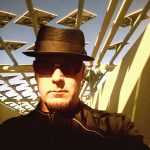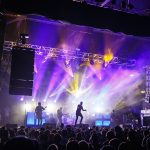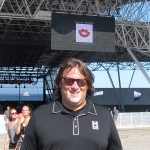One remarkable and impressive transition after another has happened for Parnelli Award-winning lighting designer Seth Jackson’s career since he was a teenager growing up in St. Louis. “I hate to say this, since my students might see this, but I only got my first job with a resume. Everything else has been an evolution of relationships,” he says. “I have always had such a passion for this business and this industry. I worked hard, I did a good job, I built the relationships, I studied the people that came before me, and the result is that I kept getting opportunities. It was never planned, per se, but I was obsessive about getting where I wanted to be.”
It would be impossible to plan such a varied career. And like the artists he works with, he makes it look easy. While he is still out working on a lot of tours (Barry Manilow and Toby Keith are just two he’s had decade-plus relationships with), he is also an associate professor and head of concert design at his alma mater, Webster University. Recently, he was named production manager for Technical Productions Inc. (TPI).
“My biggest thing is to get in the head of the artist,” Jackson says, on his approach to his work. “It is a lot like designing a play or musical. I have to understand the material. I like to research album art, interviews, and hopefully have the opportunity to dig into the artist’s likes and dislikes and build a relationship with them. In many ways, you are creating something that they have to live in and enjoy for six months to a year, so it makes sense to develop an environment that makes the touring artist feel secure and comfortable.”

The Early Breaks
Jackson grew up in Mehlville, MO, a suburb south of St. Louis. At 16, he saw Billy Joel in concert, and he was inspired. He connected with a local special event professional named Fred Berra, whose Aries event company also sold DJ lights. At 17, Jackson bought a six-channel Leprecon board and six PAR cans, and he and a buddy launched a DJ company. Meanwhile, Berra was taken by the young man and hired him for some work. “My first paid gig was for Fred,” Jackson says.
He chose Webster University to study theater lighting, because, “I didn’t just want a degree, I wanted to get my hands on things.” Concurrent with his theater studies, he taught himself concert lighting by reading back issues of Lighting Dimensions, an industry magazine. Working on a church’s Easter extravaganza, he had rented a Vari*Lite VL1. “They were impressed that I didn’t break it!” So impressed that, after he graduated, Vari-Lite hired him. He started out as a technician and duties included sweeping the floors to being one of the last techs to go out with the original VL1 Console.
His first tour was with country music’s Lorrie Morgan in 1994. “She had hired Kenny Ortega to choreograph her show and Valerie Groth to design it, both of whom had a great sense of theater. There were these very specific lighting moments, and Kenny used to say things like, ‘That’s good — but what am I not seeing?’ He was a great coach, always getting me to look at the stage in a different way. Just being around him was like a grad school education.” As for Groth, she would catapult him into his next career breakthrough. In 1996, she asked him to program the lighting for her longtime client Kenny G, who was gearing up for a three-year tour. Then, early in rehearsals, she said to him, “Oh, and by the way, I’m leaving to go home to Nashville to raise my son and have a normal life, so you’re going to take this out on tour and, oh yeah, nobody on the crew thinks you’re up to it.”

He would earn the spot, though, handling three major legs of an arena tour that took him to Europe, Africa and Asia. He was in a Johannesburg hotel room on that tour when the phone rang at two in the morning, as happens in this business. Tour manager Keith Dean was at the other end asking him to fill in for a Manilow show. The year was 1999, and Jackson has been serving Manilow ever since, from world tours to one-offs, to a residency in Las Vegas. (Manilow completed his farewell tour in mid-2015).
Next he eased into the LD chair for Don Henley when the Eagle was at the height of his solo career. “From an artistic standpoint, that was the best thing that could have happened to me,” he says. “He’s brilliant, and knows what he wants so specifically that it was a true challenge.” Jackson shrugs off the reputation that Henley has for being notoriously difficult. “He does have a tendency to dismiss people who frankly can’t keep up with him, but I loved that challenge. He would throw out obscure artistic references and I would keep up with him, which I think he appreciated. I think he stretched me further as a designer than anyone else, and the work I did on that tour is absolutely some of the best I’ve done in my entire career.”
Then it was back to Manilow, where he experienced a rare disappointment. “Manilow’s ‘first’ farewell, in 2004, bugs me the most.” Jackson says. “I had been asked to direct the show, and that was my first time doing that big job. As a result, I didn’t spend as much time on the lighting design as I would have liked.” He says at least he got to his “salute to Genesis” tribute on that tour using a rig of 80 VL2Cs in automated triangles. “But with the added responsibilities of staging the whole show, I never got to spend the programming time for the show I wanted to do for 20 years … eh, one day, I’ll try it again.”
But the following year, Manilow offered new challenges and opportunities. As he set up a residency in the Las Vegas Hilton in 2005, Jackson quickly realized that, artistically, there was so much more he could expand on, knowing that once the light was hung and focused, it wasn’t going to be moved to the next arena. “And this was structured with a legitimate stage manager who could call all the cues for lights and scenery — some of which was flying,” he explains. This gig also came with a complimentary union lighting board operator, giving him the opportunity to move into strictly designing shows and spending less time on the road. The timing for this was perfect, as he was increasingly in demand. “It was a great transition for me — while that ran for seven years, I was able to also work for Hilary Duff, Carrie Underwood, Jason Mraz, American Idol Live and others. It was arguably my most prolific period.” (He would take home two Parnelli Awards, shared with TPI’s Elizabeth O’Keefe, in 2007 and 2008, for Toby Keith tours).

The Droids He Was Looking For
Jackson was enjoying a successful trajectory as a concert lighting designer when an unusual opportunity came up in 2009. He got a call to work under the direction of one of his idols since he was 16 at that Billy Joel concert — Steve Cohen. Cohen was designing a live touring show pairing Star Wars imagery with the movie’s music performed by a full orchestra. “There was something so intriguing about working with Steve … plus, I mean, come on — it was Star Wars! That was my entire childhood, and to be able to work with CP30, rehearse in London … I had to do it!” For Jackson, the biggest challenge in being the associate director was to actually be Cohen. Jackson had to “crawl inside Steve’s brain” and do work in his style. “Steve had to leave at times for a Joel/Elton John gig, and we had to look after the show as he would. Then I was the guy on the road, and any adjustments had to be made through that kaleidoscopic mind.” The unique show was such a hit it toured the world for three years.
After Star Wars, back home in St. Louis, he had a conversation with his alma mater’s University Dean of Fine Arts, Peter Sargent. Sargent was looking to expose the technical students to concert touring. Jackson was the perfect fit, but there were conditions, as he was not ready to garb the tweed-jacket-with-the-brown-elbow-patches full time. “I told them that I was no good to them if I wasn’t also out working in the industry. Otherwise, there are better people with more degrees than me that can teach the grand picture of warm and cool lighting. My advantage is I’m in an industry that is changing constantly.” Today, the University offers one of the only BFA programs in Concert Design. “We’ve got students leaving the program and going to Upstaging, Bandit — and one is in South America doing concert work,” he says with a hint of pride. “I really enjoy being here and working with these kids who want to go into my side of the business. They are so hungry for more knowledge, and they are constantly asking me to do additional classes. It feeds my work, too.”
And he’s very much in the trenches. Since 2003 he’s been designing every Keith tour. “That’s a great part of my year, getting together around Memorial Day with that hilarious bunch of guys,” he says. Asked what it’s like to work every year with an artist with such a long repertoire of hits that the set list doesn’t vary that much from tour to tour, Jackson says it’s important to not reinvent for the sake of reinvention. “When [Keith] does Courtesy of the Red, White, and Blue, you’re not going to do something other than use red, white, and blue.” He laughs and tells the story of famed LD Marilyn Lowey, longtime Neil Diamond designer, saying her approach to his “Sweet Caroline” has not changed since 1972. “The rig has changed, the tools, but not the approach, because … well, why would you?”
A Personal Thing
Speaking of rig, a key part of his teaching and his ability to stay on top of his concert touring game is keeping up with the sheer volume of new gear. “There’s so much of it!” he sighs. “But what I’ve discovered is that it is really more about relationships. It’s the people behind the product that draws me to it.” He points out his strong relationship with Robe, who brought him to their factory in the Czech Republic town of Valašské Meziříčí. “I’ve spent time with [co-founder/owner] Josef [Valchar], and talked to him and his team about product, and that means more to me than some other light coming out that does mostly the same thing slightly differently. And you can call those people like [A.C.T Lighting’s] George Masek at three in the morning about a problem — I want to be able to get people on the phone when I’m in trouble. I also want to be able to say, ‘This is my budget, let’s work together to find a solution.’ It’s always a personal thing.”
In January, Jackson was named production designer of Technical Productions Inc., a live event company founded in 1989 by Michael O’Keefe. The St. Louis-based TPI operates out of a 24,000 square foot facility in St. Louis suburb, and they design and produce events involving lighting, staging, audio, video, and special effects. “This is a huge step forward for both of us, and we’re both able to service our existing and potential clients better because of this synergy,” says O’Keefe. “For Seth, he has better facilities at his disposal and the support of a full service office. And TPI gains full-time access to his design talent.”
“Instead of sitting around by myself, I have a room full of talented people to bounce ideas off of,” Jackson says of this partnership. “This is a nice bump up from the early days of me sitting with my laptop in some abandoned warehouse wondering if something looks good or not!”
Clearly what he’s doing is more good than not. “Seth is absolutely one of the most creative designers working today,” O’Keefe says.


